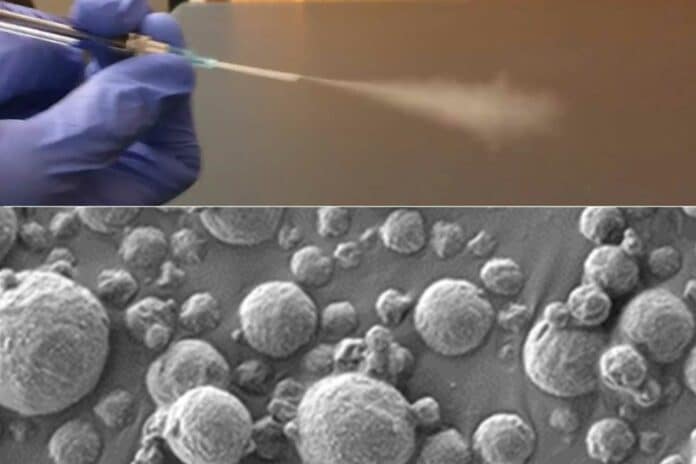Getting a special kind of X-ray called low-dose computed tomography can help find lung cancer early and improve chances of survival, especially in people at higher risk. However, not everyone can get this screening because it’s not easy to access and costs a lot. So, some people still face challenges in getting diagnosed with lung cancer.
MIT scientists developed a new technology to diagnose lung cancer easily. Their approach involved inhaling nanoparticle sensors and then taking a urine test that revealed the presence of the tumor.
A cool new test uses tiny sensors you can breathe in with a special device like an inhaler or nebulizer. If these sensors find proteins linked to cancer in your lungs, they send a signal that accumulates in the pee. And you can quickly check if you have a tumor by using a simple paper strip on your urine.
This new way of checking for lung cancer might replace or add to the usual method, low-dose computed tomography (CT). This could be really helpful in countries where there aren’t many CT scanners, especially in places where people don’t have a lot of money.
Sangeeta Bhatia, the John and Dorothy Wilson Professor of Health Sciences and Technology and Electrical Engineering and Computer Science at MIT, said, “Around the world, cancer is going to become more prevalent in low- and middle-income countries. The epidemiology of lung cancer globally is that it’s driven by pollution and smoking, so we know that those are settings where accessibility to this kind of technology could have a big impact.”
These tiny sensors are made of polymer nanoparticles. They have a special coating with something like a DNA barcode. When these sensors come across enzymes called proteases, which are usually more active in tumors, the coating is cut off from the particle. This barcode-like thing eventually gathers in the urine and gets out of the body when you pee.
Qian Zhong, an MIT research scientist, said, “When we developed this technology, our goal was to provide a method that can detect cancer with high specificity and sensitivity and also lower the threshold for accessibility so that hopefully we can improve the resource disparity and inequity in early detection of lung cancer.”
The scientists made two types of these tiny particles: a liquid form that can turn into a mist and be breathed in with a nebulizer and a dry powder that can be taken using an inhaler.
When these particles get to the lungs, they get absorbed into the tissue. Here, they meet enzymes called proteases. Some of these proteases are very active in tumors, helping cancer cells move around by cutting proteins in the surrounding area. These cancer-related proteases cut off the DNA barcodes from the sensors. These barcodes then travel in the blood until they are in the urine.
In the earlier versions of this technology, scientists used mass spectrometry to check for these DNA barcodes in the urine. But this needs special equipment that might not be available in some places. So, for this version, the scientists made a simpler test using a paper strip, which is way easier to use.
The scientists made the paper strip to find four different DNA barcodes, and each barcode shows if a specific protease exists. You don’t need to do anything special to the urine before using the strip, and you can check the results in about 20 minutes after taking the urine sample.
The scientists tried their new diagnostic method on mice specially bred to develop lung tumors similar to humans. They gave the sensors to the mice about 7.5 weeks after the tumors started forming, which is like stage 1 or 2 cancer in humans.
In the first tests on the mice, the scientists checked 20 different sensors meant to find various proteases. Using an intelligent computer program to study the results, they figured out that only four of these sensors could accurately show if there were early-stage lung tumors. They then checked this combination on the mice and found it could spot the tumors accurately.
Scientists noted, “For use in humans, more sensors might be needed to make an accurate diagnosis, but that could be achieved by using multiple paper strips, each of which detects four different DNA barcodes.”
The scientists now want to check if the sensors they used on mice will also work for finding cancer in human biopsy samples. In the future, they plan to do tests on real people through clinical trials. Another company has already tested a similar sensor for liver cancer and a type of hepatitis.
In places where there aren’t many CT scanners, this technology could be a big step forward in screening for lung cancer, especially because you can get the results in just one visit.
Bhatia said, “The idea would be you come in and then you get an answer about whether you need a follow-up test, and we could get patients who have early lesions into the system so that they could get curative surgery or lifesaving medicines.”
Journal Reference:
- Qian Zhong, Edward Tan, et al. Inhalable point-of-care urinary diagnostic platform. Science Advances. DOI: 10.1126/sciadv.adj9591
